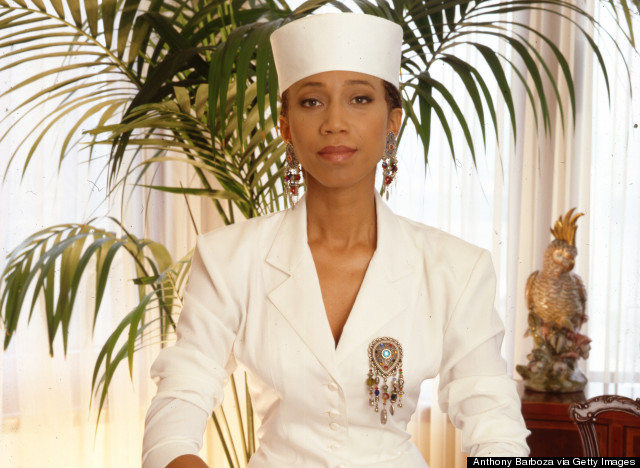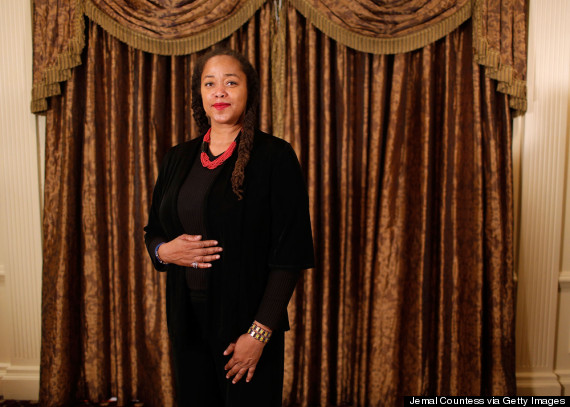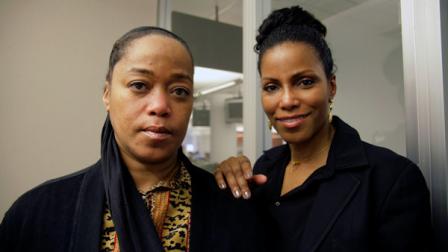



Attallah Shabazz (born November 16, 1958)

Attallah is the eldest daughter of Malcolm X and Betty Shabazz. She works as an artist, actress, theatrical director and producer, and lecturer.

Attallah is the eldest daughter of Malcolm X and Betty Shabazz. She works as an artist, actress, theatrical director and producer, and lecturer.
Qubilah Shabazz (born December 25, 1960)


Qubilah is the second daughter of Malcolm X and Betty Shabazz. She was reportedly arrestedfor allegedly plotting to have Louis Farrakhan killed, believing he played a role in her father's death. Shabazz was four-years-old when she witnessed her father's assassination. She attended Princeton University and has mostly remained out of the spotlight and the public eye. Little is known about her life today. She's the mother of Malcolm Shabazz, the first male born into the family, who was killed last year in Mexico at the age of 28.
Ilyasah Shabazz (born July 22, 1962)

Ilyasah is the third daughter of Malcolm X and Betty Shabazz. She works as a community organizer, activist, and motivational speaker. She's also an author who has written and edited a number of books including "Growing Up X."

Ilyasah is the third daughter of Malcolm X and Betty Shabazz. She works as a community organizer, activist, and motivational speaker. She's also an author who has written and edited a number of books including "Growing Up X."
Gamilah Lumumba Shabazz (born 1964)
Gamilah is the fourth daughter of Malcolm X and Betty Shabazz. Little public information is available about her present life.
Gamilah is the fourth daughter of Malcolm X and Betty Shabazz. Little public information is available about her present life.
Malaak Shabazz (born September 30, 1965)

Malaak is a twin and she and her sister Malikah are the youngest daughters of Malcolm X and Betty Shabazz. She was born in the months after her father was assassinated.

Malaak is a twin and she and her sister Malikah are the youngest daughters of Malcolm X and Betty Shabazz. She was born in the months after her father was assassinated.
Malikah Shabazz (born September 30, 1965)
Malikah last made headlines in 2011 when she plead guilty to identity theft and was sentenced to five years probation.
Malikah last made headlines in 2011 when she plead guilty to identity theft and was sentenced to five years probation.
Betty Shabazz and Malcolm X both left behind six beautiful daughters. The pair had no boys, just girls, two of which are twins. Meet Attallah, Qubilah, llyasah, Gamilah, Malikah & Malaak Shabazz, six women who carry on such an amazing legendary legacy.
Attallah Shabazz is the first born of the legendary pair Betty Shabazz and Malcolm X. Attallah resembles her father. She was born in 1958 -
Malaak Shabazz is a twin. Her and her twin sister Malikah were born in 1965 after the assassination of their father.
Ilyasah Shabazz was born in 1962, she is the third daughter of Malcolm X and Betty Shabazz.
Qubilah Shabazz: An 'Ideal Young Lady'
Unlike her mother and sisters, Qubilah Shabazz is not an esteemed professor, nor an aspiring actress. She is not the oldest child, nor the baby. Her moment in the spotlight was fleeting and tragic, and occurred on Feb. 21, nearly 30 years ago.
That was the day she and her three sisters accompanied their pregnant mother to the Audubon Ballroom in Harlem. They sat in the audience, saw their father, Malcolm X, walk onto the stage, and then heard the gunfire as he fell to the floor -- shot to death by an assassin.
But yesterday, Ms. Shabazz, 34, became notorious, accused of hiring an assassin to kill the leader of the Nation of Islam, Louis Farrakhan -- the man who was once her father's protege, then his successor, and in the minds of some of her family, ultimately, his betrayer.
It is a suspicion her mother, Dr. Betty Shabazz, has held for 30 years. When asked last March whether she believed Mr. Farrakhan was involved in her husband's death, Dr. Shabazz said: "Of course, yes. Nobody kept it a secret. It was a badge of honor. Everybody talked about it, yes." When asked later to elaborate, she told another interviewer that she had not "changed my position in 30 years."
It is not known how much Qubilah Shabazz believed in that theory, but she was indicted in Minneapolis yesterday by a Federal grand jury on charges of using the telephone and crossing state lines in the course of trying to hire someone to kill Mr. Farrakhan. The accusations stunned some who knew Ms. Shabazz. Percy Sutton, the former Manhattan borough president, who served as lawyer to Malcolm X and remains a close family friend, said she was an "ideal young lady."
"Nothing in her background would suggest to me that she could ever be involved in any criminal matter, including conspiracy," said Mr. Sutton, whose enterprises includes Inner City Broadcasting Corporation. "Dr. Shabazz has raised her daughters to be outstanding women."
Mr. Sutton would not say what Ms. Shabazz did for a living. Suggesting that the family was prepared for the possibility of an indictment against Ms. Shabazz, Mr. Sutton said: "I have been aware of the pending possibility of this since last week and have been involved in preparing for the eventuality."
Mr. Sutton said he planned to leave for Minneapolis today.
The second of six girls, Ms. Shabazz was born on Christmas Day, 1960. Gordon Parks, the famed photographer and film director, was her godfather. Not yet 5 years old when her father was murdered, her father's rise and fall within the Nation of Islam played a major role in her early childhood, with the firebombing of her family's home in East Elmhurst, Queens, on Feb. 13, 1965, and Malcolm X's murder a week later. Three Black Muslims were convicted of the killing.
Ms. Shabazz and her five sisters grew up under the tutelage of their mother, who gave birth to twins after her husband's death, and while rearing six children, went on to attain her doctorate and become director of communications and public relations at Medgar Evers College in Brooklyn.
Mrs. Shabazz kept her children in a tight embrace. Her oldest daughter, Attallah, an actress and playwright, told USA Today in 1993 that her mother hid copies of Malcolm X's autobiography from her and her sisters to shield them from published pictures of their father's bloodied body.
"But my sister Qubilah and I found them," she said. They wanted to learn all that they could not remember about their slain father, the elder Ms. Shabazz recalled.
The girls grew up in New York City, moving from Queens after the assassination to a two-story brick house in a working-class neighborhood in Mount Vernon, N.Y. A former neighbor, Mary Ryan, said yesterday that she remembered young Qubilah as being very shy. She said she never heard family members speak about Malcolm X, except once when Qubilah was small. "She came into my driveway and said, 'Do you know who my father was?' " Ms. Ryan recalled.
Eventually, Ms. Shabazz moved to New York City. Unlike her sister Attallah, who received acclaim for her involvement in the arts, and speeches on the lecture circuit, or her younger sister Gamilah, a rapper, Qubilah has received little attention from the news media. Last September, she moved to Minneapolis.
In the past four years, Malcolm X has re-emerged as an icon and hero. The director Spike Lee told his life story in the movie, "X," prompting a slew of news specials and documentaries about the slain activist. Rappers have quoted his speeches on records, and the letter "X" became ubiquitous symbol on T-shirts and baseball caps.
But before the mania, when his image was still that of a racial demagogue and his teachings were often overshadowed by those of his contemporary, the Rev. Dr. Martin Luther King Jr., Malcolm X's family bore the responsibility of telling his story, and keeping his memory alive.
Often in interviews, they spoke not of the fiery orator, but the tender husband and father. Attallah Shabazz, who is writing a book about her father, told The Los Angeles Times in 1989 that "he was actually a mush, a real pushover when it came to his girls."
"You were never a bad girl," she said. "You could make many mistakes."
But memories of old times did not ease the ache of her father's absence, she said.
"You would rather just have him right there beside you for his birthday," Attallah Shabazz said in 1989. "And instead of being out on the lecture circuit commemorating his memory, I would rather just be able to take him out to dinner."

Ilyasah Shabazz, right, and Malaak Shabazz, daughters of slain civil rights leader Malcolm X,

She picked up courses at Brooklyn State College School of Nursing, where her own unpleasant and insecure early childhood experiences motivated her to dedicate her energies to improving the health and welfare of young people. At Muhammad Mosque No. 7 in Harlem, New York, she met Malcolm X, a charismatic leader of the Black Muslims, and began studying for membership in the Nation of Islam. The leader of the Nation of Islam at that time, Elijah Muhammad, enjoined his followers to abandon their given surnames and take up the name "X." Their birth names were connected to American slavery, he argued, and thus were vestiges of slaveholders' attempts to crush any signs of African culture and individual assertion in their property. To adopt the name "X" was to abandon the victimized past of slavery, and to acknowledge the African families and communities that the descendants of American slaves had lost. Shabazz changed her name to Betty X.
In 1956 Shabazz earned her nursing degree, and she received her nursing license from the state of New York on 14 January 1958. That same day she married Malcolm X in Lansing, Michigan. During their seven years together, "Sister Betty" as she became known in the Nation of Islam, preferred to remain behind the scenes. She had six daughters with Malcolm: Attallah, Ilyasah, Gamilah, Qubilah, and twins, Malika and Malaak. She focused on raising her children as good Muslims in a tranquil home, but she balanced this domestic life with occasional public appearances. Shabazz was particularly effective in speaking out against stereotypes of women in the Nation of Islam community, and in defining a national agenda for African American women that grounded their social justice activism in religious faith and commitment to their families and communities. In public discussion of her marriage to Malcolm X, she presented a side of the civil rights figure that softened violent and adversarial images of him which had stoked white Americans' anxieties about black masculinity and black nationalists.
By 1964, tensions brewed between Malcolm X and some of the Nation's leadership, including his mentor, Elijah Muhammad. The inner circle of the Nation was threatened by Malcolm's national influence and visibility, and in turn Malcolm was shocked and disappointed by observations of corruption in the ranks and by Muhammad's admission to having adulterous relationships with several of his secretaries. A disillusioned Malcolm X persuaded Shabazz to join him in converting to the Sunni Muslim faith. She took up the surname "Shabazz" after his name change to El-Hajj Malik El-Shabazz, upon completion of his spiritual pilgrimage to the holy land of Mecca. Like other civil rights activists, they fielded threatening telephone calls and death notes, which culminated in the firebombing of their Elmhurst, N.Y., home in 1965. Twenty-eight-years old and pregnant with the twins, Shabazz was home with her husband and children as their residence was engulfed in flames, but miraculously no one was injured.
Later that year on 21 February, tragedy struck again. As Malcolm began a speech in upper Manhattan's Audubon Ballroom, an argument erupted between two men in the audience. When he stepped in front of the podium to calm them down, Shabazz and her four eldest daughters watched in horror as three men shot him. The crowd restrained one gunman, Talmadge Hayer, until police arrived, and in the weeks that followed police arrested Norman 3X Butler and Thomas 15X Johnson, both members of the Nation of Islam, on charges of murdering Malcolm X.
All three men were tried for first-degree murder. On 14 April 1966, the Supreme Court sentenced them to life in prison. As Russell J. Rickford wrote in his 2003 biography, Betty Shabazz: A Remarkable Story of Survival and Faith Before and After Malcolm X, these convictions did not alleviate her suspicions, shared by many of Malcolm's aides and allies, that the Nation of Islam had commissioned Malcolm's assassination, with the support of the federal government. In ensuing years her suspicion extended to the charismatic minister Louis Farakkhan, a friend of Malcolm's who had denounced him upon his departure from the Nation of Islam (pp. 288-92, 493). When her troubled daughter Qubilah was indicted in January 1995 for plotting to assassinate the minister, Shabazz and Farakkhan set aside their differences to successfully prevent her daughter from serving prison time.
The decades that Shabazz spent after Malcolm X's shocking death were demanding ones. While working full time and raising her daughters, she obtained three degrees: a BA and MA in public health education from Jersey State City College, and a PhD in education administration. After earning her doctorate in 1975 at the University of Massachusetts at Amherst, she accepted a position as a teacher and then administrator at Brooklyn's Medgar Evers College. She served there for twenty-one years, including a directorship of its office for institutional advancement and public relations.
Shabazz, who never remarried, preferred to stay out of the limelight in the decades after Malcolm X's death. Yet she kept his legacy alive by monitoring the fair and dignified use of his image and writings, by supporting efforts to improve the lives and safety of urban youth, and by emphasizing the relevance of his ideas about diversity, racial injustice, and self-knowledge. She signed papers that would lead to the establishment of the nonprofit Malcolm X and Betty Shabazz Memorial and Educational Center, in the Audubon Ballroom where her husband had once lay dying. The center sponsors civil rights and human rights workshops in collaboration with state and national agencies, educational empowerment activities for youth, election debates, and performances and public programs pertaining to African American and Islamic history and culture. On 3 May 1990 in New York City, Shabazz received the Urban League's most prestigious honor, the Frederick Douglass Award.
In 1997 she sustained third-degree burns when Malcom Shabazz, her troubled twelve-year-old grandson, set fire to her apartment; she died three weeks later.
Although her life was punctuated by tragedies, Shabazz accentuated themes of hope, persistence, and aspiration. After the apotheosis of the civil rights movement in the 1950s and 1960s, she drew from its legacy of reconciliation and civil action to continue to enhance the lives of young people and to establish opportunities for people of color living in America's cities. She stood as a model to African American women, exhibiting the stamina, grace, and creativity necessary for maintaining health and mental wellness while juggling the demands of family, community, and career.

No comments:
Post a Comment